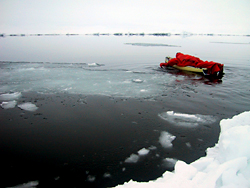Surviving: Weather North Pole

Temperature
The coldest temperature measured in the Arctic is -68C. Salt water freezes at -1.8C and the sea never goes below that. The Arctic Ocean lacks the extreme colds and high winds of the Antarctic continent. Instead there are storms causing considerable ice drift. The ice can move up to 20 km in one night! The more common drift is 1-4 km per 12 hours, changing in directions. The storms are usually short, in the range of 2-3 days. The beginning of the trek will most probably be clear but extremely cold (down to -50C), with the later season warm, wet and foggy. The coldest period is usually mid March when the night gives way. The ice reflects the most part of the rays back to space but later in the season the fog traps heat and melts the ice. Expect temperatures to range between -50C to -30C in the beginning, rising to -10C up to +5C as you are closer to the Pole. Bring a good thermometer, and find one that grades down to -50C or it could bottom out on you. The Arctic is generally colder (in skiing season) but less windy then Antarctica. The cold, fog, and drift will be your major challenge in terms of weather.
Weather, full moon and drift
Blizzards are less frequent in the Arctic then on Antarctica, but with more serious consequences. A blizzard breaks up the ice into a myriad of open water leads and simultaneously creates huge, new ice ridges as the old leads collide. Worst even, the ice is set in motion by the wind, with a drift that can reach alarming proportions. At its worst, you'll watch the digits on your GPS flicker with the speed of the US national debt, and almost certainly opposite your preferred direction.

Another hazard of the North Pole is the full moon. This phase brings on a high tide and rising ocean water. To you that means breaking ice, sometimes with a sudden and powerful impact on the grounds below you. You will notice the restlessness of the ocean already days before. The ice will move around leads and sounds of moving freight trains as the ice collides will be heard from a distance (if you are lucky). Some polar expeditions have experienced the ice braking up so rapidly around them, that they must jump from pan to pan, bewildered about what to do. Don't be close to the shore in the full moon phase if you can avoid it and always camp on thick, old ice whenever possible.
Water
"Black skies" or "water sky” are vertical black shadows in the sky reflecting leads of open water just below the shadow. "Fata Morgana" or Arctic mirages are caused by reflections of water and ice. When combined with temperature inversions, they create illusions of solid, well-defined features where there are none. "Extremely high horizon refraction" is refraction of sun light due to cold dense polar air causing an increase in brightness. Low on the horizon polar sunsets have sun disks compressed into a flat line! Site dedicated to the Aurora Borealis is the Arctic equivalent of Antarctica's Aurora Australis, the Northern Lights, but is only visible in the dark season. In the summer months the Arctic ice enjoys perpetual sunlight "midnight sun”.

Phenomenon
The Arctic Ocean sports the same sundogs, halos and diamond dust of Antarctica, but they look different in the Arctic's. Arctic sundogs and halos often precede bad weather. Clouds are often none, or low and dark.
Whiteout is caused by fog and white skies over a snow covered surface. Whiteout causes a loss of depth perception and serious difficulties scouting the route from a distance. At clear days instead, very clear air allows seeing very far, but causes difficulties judging distance. Scouting the route is very easy and the ice is shimmering and beautiful.